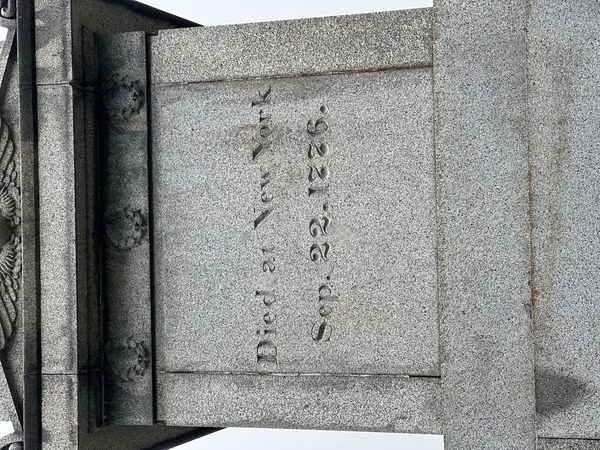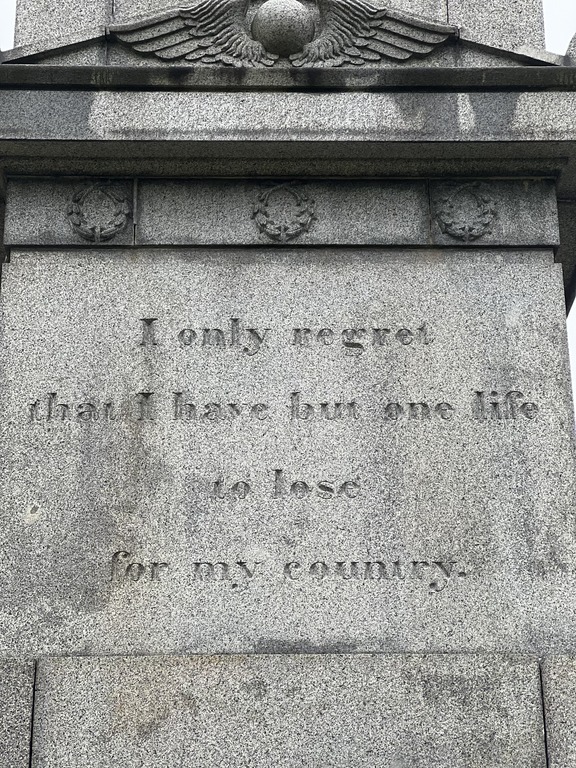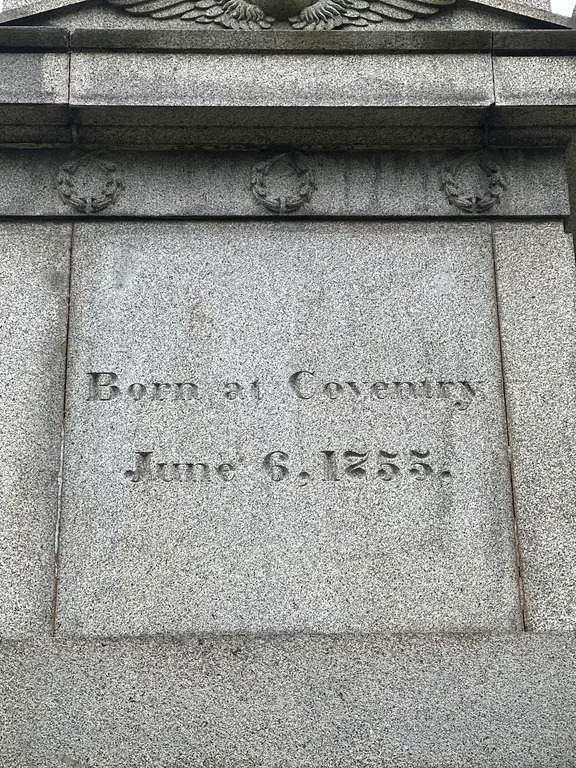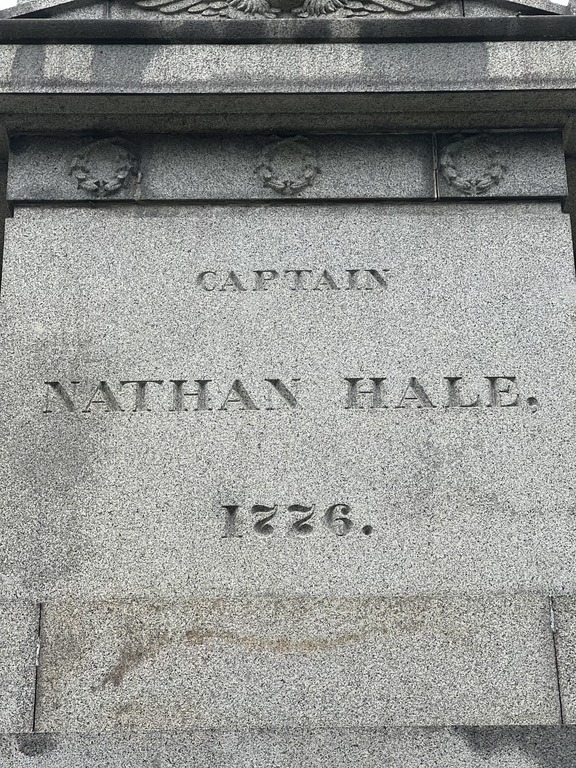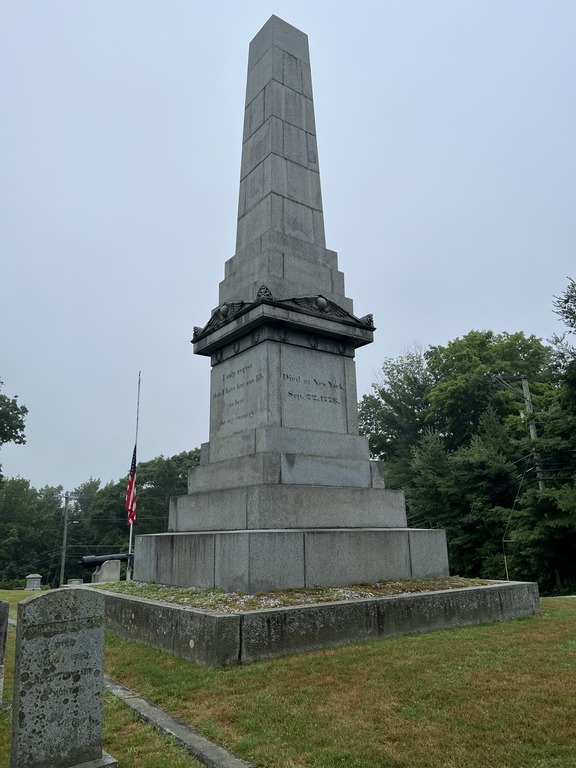Author: President Gen John Thomas Manning M.Ed.
Nathan Hale was born on 6 June 1755 in Coventry, Tolland County, Connecticut.
At the age of 14, he went to Yale College in New Haven, where he studied to be a school teacher. He took his first teaching job upon graduating in 1774 in East Haddam, but the following year, he took a job in New London at 19. Nathan was well-liked and known for his conscientiousness. Being college-educated, he was held in high regard by the community. Nathan was the first schoolmaster in Connecticut to make regular classes for female students.
Nathan received word that the Revolution had broken out in Massachusetts at the school on 22 April 1775. That evening, the local townspeople had a meeting where Nathan asked to be let out of his contract because he considered it his duty to fight for his country. Hale received a Lieutenant's commission in Connecticut's 7th Regiment and traveled to Boston in September. There, they joined the brigade of General John Sullivan, and Nathan was soon promoted to Captain of the regiment.
He saw no military action in Boston, and when the British abandoned the city, he went with the Continental Army to Long Island to defend New York City. His regiment did not see action here either when the British attacked and took the island, much to Nathan's disappointment. After George Washington moved his army back to Manhattan, the General devised a plan to place a spy within the British ranks on Long Island to find out when and where they would move against Manhattan.
Nathan volunteered for the mission because he felt that he hadn't done anything useful yet in the war. He was dropped off at Huntington, Long Island, on 12 September 1776. Unbeknownst to him, the British would invade Manhattan and drive Washington out of New York on the 15th, making his mission unnecessary, but since Nathan didn't know it, he continued with his mission.
He posed as a schoolteacher looking for work, gathered information on British troop movements and strength, and eventually returned to Huntington, where he was to be picked up. Accounts vary on how exactly Nathan was discovered by the British. Some accounts have a Tory relative, a local who recognized him, or a British soldier who recognized him, giving him up. At some point, British Lieutenant Colonel Robert Rogers, knowing Nathan was a spy, approached him at a tavern and pretended to be a patriot sympathetic to Nathan's views. Nathan told him his mission, and Rogers captured him.
Nathan was immediately sent to New York City and interrogated by General William Howe, who, without trial or jury, sentenced him to death. On 22 September, he was marched to a tree in an apple orchard in New York and allowed to say some last words. History tells us Nathan's last words were, "I only regret that I have but one life to give for my country." For his bravery and love for his country, he earned a well-deserved spot in America's pantheon of heroes from the Revolutionary War.
After his execution on 22 September 1776 in New York, he was buried in an unmarked grave. A cenotaph monument was erected at Nathan Hale Cemetery in Coventry.
Author: Rev. Edward Everett Hale
Nathan Hale, a martyr soldier of the American Revolution, was born in Coventry, Conn., June 6, 1755. When but little more than twenty-one years old he was hanged, by order of General William Howe, as a spy, in the city of New York, on September 22, 1776.
At the great centennial celebration of the Revolution, and the part which the State of Connecticut bore in it, an immense assembly of the people of Connecticut, on the heights of Groton, took measures for the erection of a statue in Hale’s honor. Their wish has been carried out by their agents in the government of the State. A bronze statue of Hale is in the State Capitol. Another bronze statue of him has been erected in the front of the Wadsworth Athenaeum in Hartford. Another is in the city of New York.
Nathan Hale’s father was Richard Hale, who had emigrated to Coventry, from Newbury, Mass., in 1746, and had married Elizabeth, the daughter of Joseph Strong. By her he had twelve children, of whom Nathan was the sixth.
Richard Hale was a prosperous and successful farmer. He sent to Yale College at one time his two sons, Enoch and Nathan, who had been born within two years of each other. This college was then under the direction of Dr. Daggett. Both the young men enjoyed study, and Nathan Hale, at the exercises of Commencement Day took what is called a pert, which shows that he was among the thirteen scholars of highest rank in his class.
From the record of the college society to which he belonged, it appears that he was interested in their theatrical performances. These were not discouraged by the college government, and made a recognized part of the amusements of the college and the town. Many of the lighter plays brought forward on the English stage were thus produced by the pupils of Yale College for the entertainment of the people of New Haven.
When he graduated, at the age of eighteen, he probably intended at some time to become a Christian minister, as his brother Enoch did. But, as was almost a custom of the time, he began his active life as a teacher in the public schools, and early in 1774 accepted an appointment as the teacher of the Union Grammar School, a school maintained by the gentlemen of New London, Conn., for the higher education of their children. Of thirty-two pupils, he says, “ten are Latiners and all but one of the rest are writers.”
In his commencement address Hale had considered the question whether the higher education of women were not neglected. And, in the arrangement of the Union School at New London, it was determined that between the hours of five and seven in the morning, he should teach a class of “twenty young ladies” in the studies which occupied their brothers at a later hour.
He was thus engaged in the year 1774. The whole country was alive with the movements and discussions which came to a crisis in the battle of Lexington the next year. Hale, though not of age, was enrolled in the militia and was active in the military organization of the town.
So soon as the news of Lexington and Concord reached New London, a town-meeting was called. At this meeting, this young man, not yet of age, was one of the speakers. “Let us march immediately,” he said, “and never lay down our arms until we obtain our independence.” He assembled his school as usual the next day, but only to take leave of his scholars. “He gave them earnest counsel, prayed with them, shook each by hand,” bade them farewell.
It is said that there is no other record so early as this in which the word “independence” was publicly spoken. It would seem as if the uncalculating courage of a boy of twenty were needed to break the spell which still gave dignity to colonial submission.
He was commissioned as First Lieutenant in the Seventh Connecticut regiment, and resigned his place as teacher. The first duty assigned to the regiment was in neighborhood of New London, where, probably, they were perfecting their discipline. On September 14, 1775, they were ordered by Washington to Cambridge. There they were placed on the left wing of his army, and made their camp at the foot of Winter Hill. This was the post which commanded the passage from Charlestown, one of the only two roads by which the English could march out from Boston. Here they remained until the next spring. Hale himself gives the most interesting details of that great victory by which Washington and his officers changed that force of minute-men, by which they had overawed Boston in 1775, into a regular army. Hale re-enlisted as many of the old men as possible, and then went back to Coventry to engage, from his old school companions, soldiers for the war. After a month of such effort at home, he came back with a body of recruits to Roxbury.
On January 30th his regiment was removed to the right wing in Roxbury. Here they joined in the successful night enterprise of March 4th and 5th, by which the English troops were driven from Boston.
So soon as the English army had left the country, Washington knew that their next point of attack would be New York. Most of his army was, therefore, sent there, and Webb’s regiment among the rest. They were at first assigned to the Canada army, but because they had a good many seafaring men, were reserved for service near New York, where their “web-footed” character served them well more than once that summer. Hale marched with the regiment to New London, whence they all went by water to New York. On that critical night, when the whole army was moved across to New York after the defeat at Brooklyn, the regiment rendered effective service.
It was at this period that Hale planned an attack, made by members of his own company, to set fire to the frigate Phoenix. The frigate was saved, but one of her tenders and four cannons and six swivels were taken. The men received the thanks, praises, and rewards of Washington, and the frigate, with her companions, not caring to risk such attacks again, retired to the Narrows. Soon after this little brush with the enemy, Colonel Knowlton, one of the Connecticut regiments, organized a special corps, which was known as Knowlton’s Rangers. On the rolls of their own regiments the officers and men are spoken of as “detached on command.” They received their orders direct from Washington and Putnam, and were kept close in front of the enemy, watching his movements from the American line in Harlem. It was in this service, on September 15th, that Knowlton’s Rangers, with three Virginia companies, drove the English troops from their position in an open fight. It was a spirited action, which was a real victory for the attacking force. Knowlton and Leitch, the leaders, were both killed. In his general orders Washington spoke of Knowlton as a gallant and brave officer who would have been an honor to any country.
But Hale, alas! was not fighting at Knowlton’s side. He was indeed “detached for special service.” Washington had been driven up the island of New York, and was holding his place with the utmost difficulty. On September 6th he wrote, “We have not been able to obtain the least information as to the enemy’s plans.” In sheer despair at the need of better information then the Tories of New York City would give him, the great commander consulted his council, and at their direction summoned Knowlton to ask for some volunteer of intelligence, who would find his way into the English lines, and bring back some tidings that could be relied upon. Knowlton summoned a number of officers, and stated to them the wishes of their great chief. The appeal was received with dead silence. It is said that Knowlton personally addressed a non-commissioned officer, a Frenchman, who was an old solider. He did so only to receive the natural reply, “I am willing to be shot, but not to be hung.” Knowlton felt that he must report his failure to Washington. But Nathan Hale, his youngest captain, broke the silence. “I will undertake it,” he said. He had come late to the meeting. He was pale from recent sickness. But he saw an opportunity to serve, and he did the duty which came next at hand.
William Hull, afterward the major-general who commanded at Detroit, had been Hale’s college classmate. He remonstrated with his friend on the danger of the task, and the ignominy which would attend its failure. “He said to him that it was not in the line of his duty, and that he was of too frank and open a temper to act successfully the part of a spy, or to face its dangers, which would probably lead to a disgraceful death.” Hale replied, “I wish to be useful, and every kind of service necessary to the public good becomes honorable by being necessary. If the exigencies of my country demand a peculiar service, its claim to perform that service are imperious.” These are the last words of his which can be cited until those which he spoke at the moment of his death. He promised Hull to take arguments into consideration, but Hull never heard from him again.
In the second week of September he left the camp for Stamford with Stephen Hempstead, a sergeant in Webb’s regiment, from whom we have the last direct account of his journey. With Hempstead and Asher Wright, who was his servant in camp, he left his uniform and some other articles of property. He crossed to Long Island in citizen’s dress, and, as Hempstead thought, took him his college diploma, meaning to assume the aspect of a Connecticut schoolmaster visiting New York in the hope to establish himself. He landed near Huntington, or Oyster Bay, and directed the boatman to return at a time fixed by him, the 20th of September. He made his way into New York, and there, for a week or more apparently, prosecuted his inquiries. He returned on the day fixed, and awaited his boat. It appeared, as he thought; and he made a signal from the shore. Alas! he had mistaken the boat. She was from an English frigate, which lay screened by a point of woods, and had come in for water. Hale attempted to retrace his steps, but was too late. He was seized and examined. Hidden in the soles of his shoes were his memoranda, in the Latin language. They compromised him at once. He was carried on board the frigate, and sent to New York the same day, well guarded.
It was at an unfortunate moment, if anyone expected tenderness from General Howe. Hale landed while the city was in the terror of the great conflagration of September 21st. In that fire nearly a quarter of the town was burned down. The English supposed, rightly or not, that the fire had been begun by the Americans. The bells had been taken from the churches by order of the Provincial Congress. The fire-engines were out of order, and for a time it seemed impossible to check the flames. Two hundred persons were sent to jail upon the supposition that they were incendiaries. It is in the midst of such confusion that Hale is taken to General Howe’s head-quarters, and there he meets his doom.
No testimony could be stronger against him than the papers on his person. He was not there to prevaricate, and he told them his rank and name. There was no trial, and Howe at once ordered that he should be hanged the next morning. Worse than this, had he known it, he was to be hanged by William Cunningham, the Provost-Major, a man whose brutality, through the war disgraced the British army. It is a satisfaction to know that Cunningham was hanged for his deserts in England, not many years after.
Hale was confined for the night of September 21st in the greenhouse of the garden of Howe’s head-quarters. This place was known as the Beekman Mansion, at Turtle Bay. This house was standing until within a few years.
Early the next day he was led to his death. “On the morning of the execution,” said Captain Montresor, an English officer, “ my station being near the fatal spot, I requested the Provost-Marshal to permit the prisoner to sit in my marquee while he was making the necessary preparations. Captain Hale entered. He asked for writing materials, which I furnished him. He wrote two letters; one to his mother and one to a brother officer. The Provost-Marshal destroyed the letters, and assigned a reason that the rebels should not know that they had a man in their army who could die with so much firmness.”
Hale asked for a Bible, but his request was refused. He was marched out by a guard and hanged upon an apple-tree in Rutgers’s orchard. The place was near the present intersection of East Broadway and Market Streets. Cunningham asked him to make his dying “speech and confession.” “I only regret,” he said, “that I have but one life to lose for my country.”
